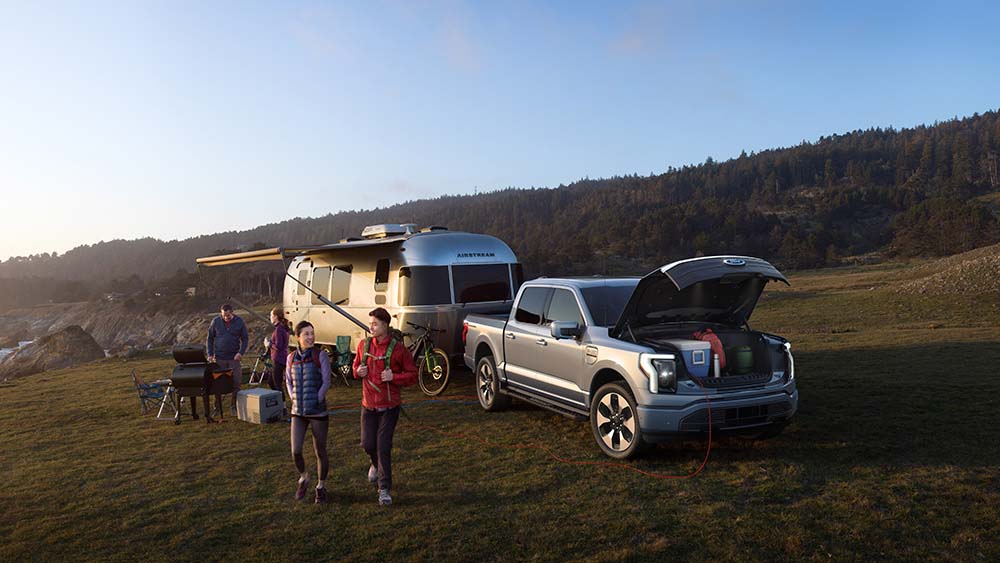Icemakers, picnic tables, coffee machines—car makers have long tried to inject a bit of lifestyle into their designs, to varying degrees of success. But what if you could turn your electric vehicle (EV) into a portable battery pack able to power high-demand devices? A new feature called vehicle-to-load (V2L) charging is reshaping how we think of—and use—cars.
What is V2L charging?
Simply put, V2L allows drivers to plug their high-powered electronics—a cell phone sure, but also an air fryer—directly into their vehicle. Auxiliary power has been available in vehicles for decades, first in the form of clever cigarette lighter adapters and more recently via dedicated USB ports and even standard three-prong outlets. So what makes V2L different? To quote everyone’s favorite not-so-handyman from the 90s: more power.
A typical car offers 12 volts of auxiliary power, yielding around 120 watts of electricity. Even a modern internal combustion engine car equipped with normal outlets and USB power ports, like the 2022 Ford Explorer, tops out at 180 watts. That’s enough to—maybe—power a laptop, or slowly charge a phone.
First introduced in 2021, V2L is today available in the Hyundai Ioniq 5, Kia EV6 (pictured below) and—as of last month—the Ford F-150 Lightning (with plenty more to come). Using a V2L adapter plugged into the charging port, the high-voltage batteries in these cars can supply around 10 times the power of the Ford Explorer. (That’s enough for Tim Taylor to grunt in approval.) And Hyundai buyers who upgrade to the Limited trim get an interior power outlet—it’s under the backseat—that supplies 1,900 watts, slightly more than a typical household circuit. Who’s ready to air fry?

How much can I power with V2L?
The answer depends on how much stuff you’ve got plugged in at the same time. Different devices have different watt requirements—a cell phone uses 2 to 6 watts when charging, an 18-bottle wine cooler uses 83 watts, that air fryer uses 1,500 watts (electronics that generate heat tend to consume the most power). Refer to the device’s documentation, add up the figures and just make sure the total doesn’t exceed the peak V2L capacity of the power port.
Parked in a remoted location and worried about running out of juice? Here’s a tip: set the limit you don’t want your battery to dip below—say, 50 percent, because you know you need that much to drive home. The car will devote the rest to V2L. Chilled wine and air-fried cauliflower bites for everyone (sparkling water for the driver)!
How long can I power devices with V2L?
Well, how big is your battery? Ford’s game changing F-150 Lightning pickup comes standard with a 98-kWh battery pack. To put that in perspective, the typical American household consumes around 30 kWh of electricity per day. That means the electric truck’s battery could power most of the main appliances in your home (bearing in mind V2L capacity limitations) for over three days.
Of course, you will need to reserve some power for driving if you’re planning a road trip. Say you’re headed to a campsite about 75 miles from home. Your new Lightning has an estimated range of 230 miles. A round trip would consume just under two-thirds of the battery’s power, and you’d be left with over 30 kWh to use for V2L charging. Goodbye camping, hello air-fryer equipped glamping.
Okay, but wait: What’s a kilowatt-hour?
Battery storage capacity is described in kilowatt-hours, which is abbreviated as kWh. A kilowatt-hour is a unit of energy equivalent to 1,000 watts (or one kilowatt) sustained for one hour.
Imagine there’s a power outage. Oh no! But let’s also imagine you have an EV with 60 kWh of energy stored in its battery. Phew! You have a few crucial appliances you want to run — a dehumidifier (240 W), a fridge (780 W), a space heater (1,500 W) — for a total of 2,520 W, or 2.52 kW. With the backup power you have sitting in the garage, you can keep things running for nearly 24 hours (the quotient of 60 kWh and 2.52 kW).
What’s next? Vehicle-to-everything
Automakers like Hyundai are studying ways EVs can store renewable energy and then discharge it into the grid during periods of peak demand, avoiding the need to build more power plants that run on fossil fuels. This is called vehicle-to-grid (V2G) power flow. In 2022, 150 V2G-enabled Ioniq 5s will hit the road as part of a car-sharing scheme in the Dutch city of Utrecht. V2L is becoming mainstream at a time when power outages are at an all-time high, thanks to climate change and an aging electrical grid. Bidirectional EVs offer peace of mind, backup power and near constant access to air fried snacks—oh yeah, and you can drive them, too.


